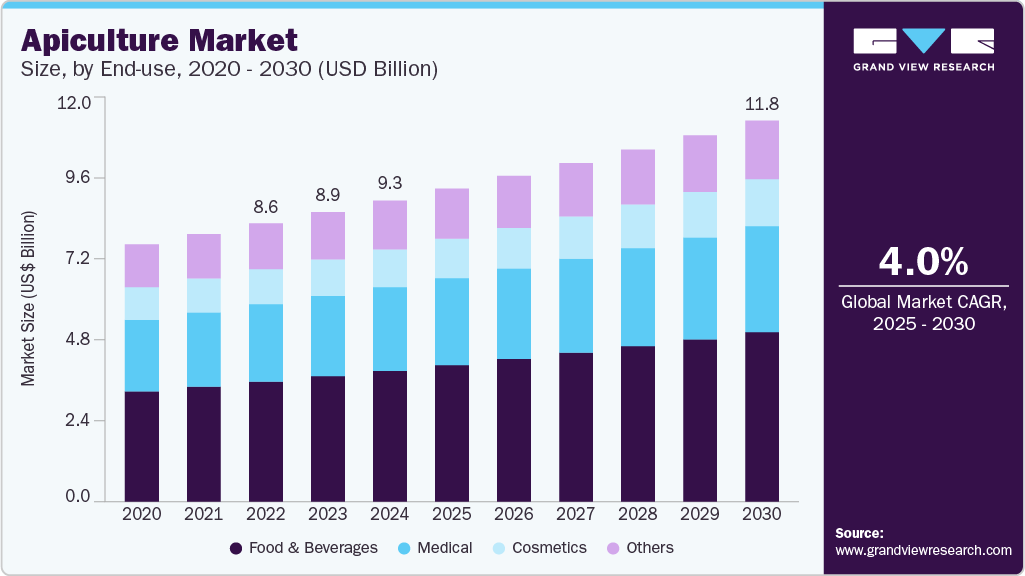The global apiculture market was valued at USD 9.31 billion in 2024 and is projected to reach USD 11.78 billion by 2030, growing at a compound annual growth rate (CAGR) of 4.0% from 2025 to 2030. This growth is driven by the versatility of bee products, which extend beyond food and beverages into sectors such as pharmaceuticals, cosmetics, and agriculture.
For example, honey and royal jelly are frequently incorporated into dietary supplements, while beeswax is a common ingredient in skincare formulations. This wide-ranging applicability enhances the market's resilience and potential for growth, as various industries increasingly invest in bee-related products to satisfy consumer demands. Additionally, beeswax serves as a binding agent and time-release mechanism for medications in the pharmaceutical industry, improving the effectiveness of drug delivery systems. Ongoing research into the medicinal properties of these products continues to reveal new applications, further establishing their significance in modern healthcare.
The demand for bee products, particularly honey and its derivatives, is witnessing substantial growth in China and globally. This increase is influenced by factors such as rising health consciousness, sustainability trends, and the adaptability of these products across multiple sectors.
Key Market Trends & Insights
- Regional Performance: The Asia Pacific region dominated the global market with a revenue share of 35.6% in 2024. The rising demand for honey in this region is driven by a shift towards natural sweeteners in food and beverages, with consumers becoming more aware of honey's health benefits as a healthier alternative to refined sugars and artificial sweeteners.
- End Use Segment: The food and beverages segment held the largest revenue share of 43.5% in 2024. This sector remains the primary application for bee products, particularly honey. As health consciousness increases, consumers are increasingly opting for natural alternatives, with honey emerging as a favored choice due to its rich flavor and health advantages.
- Product Type: The honey products segment had the largest revenue share in 2024, solidifying honey's status as the most significant product in the apiculture market. Initially valued for its medicinal benefits, honey has evolved into a staple ingredient in the food and beverage industry.
Order a free sample PDF of the Apiculture Market Intelligence Study, published by Grand View Research.
Market Size & Forecast
- 2024 Market Size: USD 9.31 Billion
- 2030 Projected Market Size: USD 11.78 Billion
- CAGR (2025-2030): 4.0%
- Asia Pacific: Largest market in 2024
Key Companies & Market Share Insights
Key players in the apiculture market are implementing various strategies, including expansion activities and partnerships, to enhance their presence and broaden the reach of their products and services. These initiatives are crucial for driving market growth.
Key Players
- Capilano Honey Ltd.
- Organic Bee Farms
- Dabur Ltd.
- NOW Foods
- Koster Keunen LLC
- Barkman Honey
- Heavenly Organics
- Strahl & Pitsch Inc.
- Miller’s Honey
- Durham’s Bee Farm
Explore Horizon Databook – The world's most expansive market intelligence platform developed by Grand View Research.
Conclusion
The apiculture market is poised for growth, supported by increasing consumer demands for natural products across various industries. As health awareness rises and consumers shift towards sustainable choices, bee products, particularly honey, are becoming integral to multiple sectors, reinforcing their importance in both the food industry and healthcare. The market outlook remains positive, with expanding applications and ongoing research into the benefits of bee products driving future growth.







